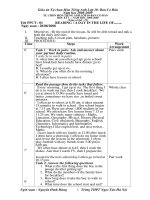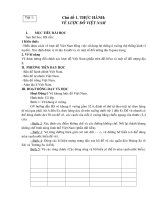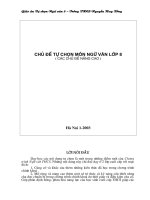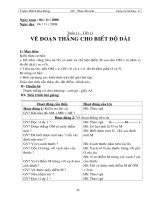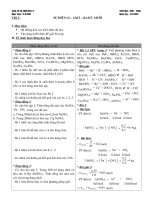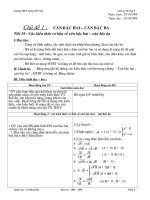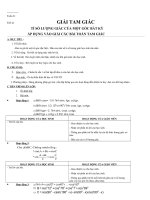GIAO AN TU CHON 7
Bạn đang xem bản rút gọn của tài liệu. Xem và tải ngay bản đầy đủ của tài liệu tại đây (194.12 KB, 27 trang )
<span class='text_page_counter'>(1)</span><div class='page_container' data-page=1>
Planning date: September 2nd<sub> </sub> <sub>Week 7</sub>
<b>TOPIC 2</b>
:<b>(Class 7) </b>
<b>Period 1 </b>
<b>TIME</b>
<b>I. Objectives:</b>
By the end of the lesson, Ss will be able to review how to ask and answer
about the time.
<b>II. Language content:</b>
<b>1. Grammar: </b>
+ What time is it?
It is one o’clock
+ What time does he get up?
He gets up at six fifteen
+ What time does she have lunch?
She has lunch at 11 o’clock.
<b>2. Vocabulary: review</b>
<b>III. Preparation:</b>
<b>1. Teacher’s</b>: Text book, exercise book, lesson plan…
<b>2. Students’</b>: workbook
<b>IV. Techniques: </b>pair-work, group-work…
<b>V. Procedures:</b>
<b>STEPS</b> <b>TEACHER’S ACTIVITIES</b> <b><sub>ACTIVITIES</sub>STUDENTS’</b>
<b>1. Warm up:</b>
<b>7’</b>
*<b>Shark attack</b>: schedules Whole class
<b>2. </b>
<b>Presentation:</b>
<b>10’</b>
<b>- </b>T reviews the grammar point of asking and answering
about the times. - Ss listen to the Tand take note.
<b>3. Practice:</b>
<b>27’</b> <b>- </b>note.T shows the exercises on the sub-board for Ss to take
- T lets Ss do the exercises in pairs.
<b>Exercises:</b>
<b>1. Look at the time then write the answers to this </b>
<b>questions:</b>
<b>What time is it? The first is done for you</b>
a. 6: 20 It is twenty past six/ It’s six twenty
b. 21: 15: ………
c. 03: 19: ………
d. 09: 15: ………
e. 15: 45:……….
f. 18: 30:……… …….
</div>
<span class='text_page_counter'>(2)</span><div class='page_container' data-page=2>
g. 09: 50: ………
h. 01: 25: ………
i. 05: 45: ………
<i>* Answers:</i>
b. It is a quarter past twenty one/ it is nine pm
c. It’s nineteen past three / it is three nineteen
d. It is a quarter past nine/ it is nine fifteen
e. It’s a quarter to sixteen/ It is forty five past fifteen
f. It is half past eighteen/ It is thirty eighteen
g. It is ten to ten/ it is fifty nine
h. It is twenty five past one/ It is one twenty five
i. It is ten to six/ It is five forty five
T guides Ss to complete and explains some models.
-T asks Ss to write down the answer on the board.
-T corrects the mistakes.
<b>2. Write the answers to the questions about your </b>
<b>mother/ father</b>
a. what does your mother/ father do?
………
b. where does she/ he work?
………
c. What time does she/ he get up?
………
d. what time does she/ he go to work?
………
e. what time does she/ he have lunch?
………
<i><b>*Answer keys:</b></i>
<b>Student’s answers</b>
-Ss work and
discuss in group.
<b>Homework</b>
<b>1’</b>
<b>- </b>Review the grammar points.
- Do exercises 3.4 in workbook (page: 21, 22)
</div>
<span class='text_page_counter'>(3)</span><div class='page_container' data-page=3>
Planning date: September 2nd <sub>Week 7</sub>
<b>TOPIC 2</b>
:<b>(Class 7) </b>
<b>Period 2</b> <b> </b>
<b>TENSE</b>
<b>I. Objectives:</b>
By the end of the lesson, Ss will be able to use present continuous tense, and
then turn into negative and interrogative.
<b>II. Language content:</b>
<b>1. Grammar: </b>Present continuous tense (S + am/ is/ are + V_ing)
<b>2. Vocabulary: review</b>
<b>III. Preparation:</b>
<b>1. Teacher’s</b>: Text book, exercise book, lesson plan…
<b>2. Students’</b>: workbook, pair-work, group-work…
<b>IV. Techniques: </b>Matching, asking and answering…
<b>V. Procedures:</b>
<b>STEPS</b> <b>TEACHER’S ACTIVITIES</b> <b><sub>ACTIVITIES</sub>STUDENTS’</b>
<b>1. Warm up:</b>
<b>10’</b>
<b>*Matching:</b>
<b>Match up the two halve in column A and column B </b>
<b>then write meaningful sentence </b>
<b>A </b> <b>B</b>
In Literature
In home economics
In history
In geography
I study the world, Its
rivers and its mountain
ranges.
I study the past and how
the world changes.
I read a book and write
about what I read.
I learn to cook and what
our bodies need.
<b>*Answer keys:</b>
1. In literature I read a book and write about what I read.
2. In home economics I learn to cook and what our bodies
need.
3. In history I study the past and how the world change.
4. In geography I study the world, its rivers and its
mountain range.
</div>
<span class='text_page_counter'>(4)</span><div class='page_container' data-page=4>
T guides Ss to match up the two halve in column A and
column B then write meaningful sentences
T asks Ss to give their answers: Ss go to the backboard and
write down the
answers in groups
<b>2. </b>
<b>Presentation:</b>
<b>15’</b>
T asks Ss to review the form and the use of the Present
Progressive Tense :
<b>* Present Progressive Tense.</b>
Ex: I’m reading newspaper now.
My sister and I are having dinner at the moment.
<i><b> (+) S + am / is / are + V_ing</b></i>
<i><b> (-) S + am/ is / are + not + V_ing</b></i>
<i><b> (?) am/ is / are + S + V_ ing</b></i>
- Ss listen to the T
and take note.
<b>3. Practice:</b>
<b>18’</b>
T asks Ss to do the following exercise.
T lets Ss compare the answers with their partners.
T gets and gives the correct answers.
<b>Write sentences, using the cues given in the present </b>
<b>continuous tense. Then turn into negative and </b>
<b>interrogative </b>
1. Lan / play/ piano/ at the moment
2. The boys/ study/ math/ now.
3. The girls/ learn/ how/ make/ cakes
4. They/ have/ breakfast/ school canteen.
5. She/ teach/ English/ school.
6. The children/ laugh/ and/ talk/ noisily
7. They / listen/ music/ now.
8. Van/ call/ her friend/ at the moment
9. The students/ read/ scientific books/ library
10. Mr. Brown/ give/ his students/ advice
* Answers
1. Lan is playing the piano at the moment.
Lan isn’t playing the piano at the moment.
Is Lan playing the piano at the moment?
2. The boys are studying math now.
The boys aren’t studying math now.
Are the boys playing math now?
3. The girls are learning how to make the cakes.
The girls aren’t leaning how to make the cakes.
Are the girls learning who to make the cakes?
4. They are having breakfast at school canteen.
They are not having breakfast at school canteen.
</div>
<span class='text_page_counter'>(5)</span><div class='page_container' data-page=5>
Are they having breakfast at school canteen?
5. She is teaching English at school.
She is not teaching English at school.
Is she teaching English at school?
6. The children are laughing and talking noisily.
The children are not laughing and talking noisily.
Are the children laughing and talking noisily?
7. They are listening to the music now.
They are not listening to the music now.
Are they listening to the music now?
8. Van is calling her friend at the moment.
Van is not calling her friend at the moment.
Is Van calling her friend at the moment?
9. The students are reading the scientific books at the
library.
The students are not reading the scientific books at the
library.
Are the students reading the scientific books at the library?
10. Mr. Brown is giving his student an advice.
Mr. Brow is not giving his student an advice.
Is Mr. Brown giving his student an advice?
<b>Homework</b>
<b>1’</b>
- Learnt by heart all the work.
- Do the exercise again.
</div>
<span class='text_page_counter'>(6)</span><div class='page_container' data-page=6>
Planning date: September 10th<sub> </sub> <sub>Week 8</sub>
<b>TOPIC 2</b>
:<b>(Class 7) </b>
<b>Period 3</b> <b> </b>
<b>TENSE</b>
<b>I. Objectives:</b>
By the end of the lesson, Ss will be able to use present simple tense, and then
turn into negative and interrogative.
<b>II. Language content:</b>
<b>3. Grammar: </b>Present Simple tense
<b>4. Vocabulary: review</b>
<b>III. Preparation:</b>
<b>1. Teacher’s</b>: Text book, exercise book, lesson plan…
<b>2. Students’</b>: workbook, pair-work, group-work…
<b>IV. Techniques: </b>Matching, asking and answering…
V. Procedures:
<b>STEPS</b> <b>TEACHER’S ACTIVITIES</b> <b><sub>ACTIVITIES</sub>STUDENTS’</b>
<b>Presentation</b>
<b>15’</b>
T introduce the lesson
1) Tenses (Thi):
<b>Simple present </b>
* I /We / You / They + V We go to school
everyday.
He / She / It + Vs,es : He usually goes to
school on foot.
* Verb BE : I + am : I am in grade 6.
He /She /It + is : He is the
best student in my class.
We /You /They + are : They are
Nam’s brothers.
* Adverbs of frequency:always,often,usually,sometimes,
rarely,never…
Adverb phrases of frequency: everyday,every
week,every summer,every Sunday..; once a day,twice a
week, three times a year…
<b> Present progressive </b>
* I + am + V-ing : I am doing my homework now.
He /She /It + is + V-ing : He isn’t doing his
homework now.
</div>
<span class='text_page_counter'>(7)</span><div class='page_container' data-page=7>
your homework now?
* now,at the moment, at the present, at this time…,
<b>Simple future </b>
* S + will + V : Tomorrow I will be thirteen.
* tomorrow, next, in the future,in 3/4/10…days, soon,
someday…
<b>Practice</b>
<b>30’</b>
<b>- </b>Ask Ss to do exercise in group
<b>I</b><i><b>. Choose the best answer:</b></i>
1. My brother and I ………….. TV every evening.
( watch- watches - is watching - watchs )
2. They ………… at home last night. (are - is - were
- was )
3. Quang ………. with vegetables at the
moment. (are loading is loading will load
-loaded )
4. Ba ……… lunch at school. (have has eat
-does )
5. Ba’s brother ……… volleyball tonight. ( will
play - plays - is playing -played )
6. Where ………..you ……….
tomorrow? ( will- go - do- go -did- go - were- go)
7. He ……… some souvenirs for her
friends 5 days ago. (buys - bought -buy - will buy)
8. Mr. Ba ……… collecting stamps.
( likes - like - is liking - are liking)
9. I ……… swim everyday. (don’t
-didn’t - won’t - wasn’t)
10. You can……… here.
(play-playing - plays - is (play-playing)
<b>II. Give the correct tenses of the verbs in brackets:</b>
<i>1.</i> My friends (be)……… students
<i>last year.</i>
<i>2.</i> The children (play)
………..……….
in the park at the moment.
<i>3.</i> ……….you (go)
……….. to school last Sunday?
<i>4.</i> My mother (cook)
………a meal now.
She ( cook)……… everyday
<i>5.</i> What……… your mother (do)
</div>
<span class='text_page_counter'>(8)</span><div class='page_container' data-page=8>
………. next week? - She (make)
………a dress.
<i>6.</i> She (brush)……… her teeth
<i>after meals.</i>
<i>7.</i> My mother (buy)……… a new
bike two months ago.
<b>Homework</b> Revision – grammar
- exercise
</div>
<span class='text_page_counter'>(9)</span><div class='page_container' data-page=9>
<b>TOPIC 2</b>
:<b>(Class 7) </b>
<b>Period 4</b> <b> </b>
<b>Comparison of adjectives</b>
<b>I. Objectives:</b>
Rather Practice in all key grammar poits
- After the lesson Ss will be able to practice fluently all key grammar point,
Exclamatory sentences, Polite request
<b>II. Language content:</b>
<b>5. Grammar: </b>Comparison of adjs.
<b>6. Vocabulary: review</b>
<b>III. Preparation:</b>
<b>1. Teacher’s</b>: Text book, exercise book, lesson plan…
<b>2. Students’</b>: workbook, pair-work, group-work…
<b>IV. Techniques: </b>Matching, asking and answering…
<b>V. Procedures:</b>
<b>STEPS</b> <b>TEACHER’S ACTIVITIES</b> <b><sub>ACTIVITIES</sub>STUDENTS’</b>
<b>Presentation</b>
<b>15’</b>
<b>Revision :</b>
1- Comparison of adjectives
Adj Comparative
* Short adj
- tall
- big
- nice
* Long adj
- beautiful
- expensive
- taller
- bigger ( than)
- nicer
more beautiful ( than)
more expensive
2- Exclamatory sentences
How + adj /adv + S + be / V ! : How beautiful she is !
What + (a / an ) +( adj) + N ! : What a beautiful girl !
3- Polite request
- Let’s + V… Yes,let’s. ; No, let’s not.
- Why don’t we + V…? / Should we + V…? / What
about + V-ing…?
That’s a good idea ./ O K. ; I’m sorry I can’t. /
No,thanks./ Another time perhaps.
-Would you (please) + V…?
- Would you like sth / to do sth…?
I’d love to. ; I’d love to but…/ I’m sorry I can’t.
</div>
<span class='text_page_counter'>(10)</span><div class='page_container' data-page=10>
<b>Practice</b>
<b>30’</b> Exercises : I/ Complete the sentences with the correct form of
words
1. Lan is one of the students in my class ( good)
2. There are …………girls than boys in my class(many )
3. A student has …………free time than a worker.
(little )
4. Mount Everest is the ………..mountain in the world
( high )
5. He likes collecting stamps. He is a stamp
…………..( collect)
6.Room 14 is ……than room 20..( comfortable )
7. This is the …….movie in this year. ( bad )
8. He teaches children. He is a …….(teach )
9. Mrs Quyen is a ….She helps us find books (library)
10. New year is the …….time of a year ( happy )
II/Rewrite the following sentences
1- Lan is better than Ba . Ba is
2The room is very nice . What „ !
Room 13 is cheaper than room 14 . Room 14 is………
She is an intelligent girl. What……….
American students have more vacations than Vietnamese students. Vietnamese students
………
Ho Chi Minh City / large / city / Vietnam. Ho Chi Minh……….
How far / Dalat / Hanoi ?...
Lan / sister / clean / kitchen floor / at the moment. ………
Phuong / good / student / my class.
………
.What / you / do / computer science
class / ?...
-Students / rehearse / play / school / anniversary /
celebration……….
There / television set / right / couch ………
Do exercise
</div>
<span class='text_page_counter'>(11)</span><div class='page_container' data-page=11>
Planning date: September 16th<sub> </sub> <sub>Week 9</sub>
<b>TOPIC 2</b>
:<b>(Class 7) </b>
Period 5
<b>QUESTION WORDS</b>
<b>I. Objectives:</b>
Rather Practice in all key grammar poits
- After the lesson Ss will be able to practice fluently all key grammar point.
<b>II. Language content:</b>
<b>7. Grammar: </b>question words
<b>8. Vocabulary: </b>review
<b>III. Preparation:</b>
<b>1. Teacher’s</b>: Text book, exercise book, lesson plan…
<b>2. Students’</b>: workbook, pair-work, group-work…
<b>IV. Techniques: </b>Matching, asking and answering…
V. Procedures:
<b>STEPS</b> <b>TEACHER’S ACTIVITIES</b> <b>STUDENTS’</b>
<b>ACTIVITIES</b>
<b>Presentation</b>
<b>10’</b> T review the question words:- Who
- What
- Which
- Why
- When
- Where
- How
Take note
<b>Practice</b>
<b>35’</b> - Ask Ss to do exerciseMathching
A B
1. Why are your friends
absent?
2. Who broke the
window?
3. Where did he go last
week?
4. What were you doing
at ten?
5. How deep is the river?
6. When will she come?
7. What is the matter with
you?
a. Next Sunday
b. Oh, nothing serious.
c. To Thai Lan.
d. Because they
weren’t invited.
e. I have a headache.
f. Someone did.
g. About 12 meters.
h. Because they are
busy.
i. We were watching
TV.
</div>
<span class='text_page_counter'>(12)</span><div class='page_container' data-page=12>
8. Why didn’t they come?
9. Did he tell you about
her?
10. What happened to you?
j. Yes, they did.
<b>II- Tenses:</b>
1. Mozart (play)……… the piano when he (be)
………three.
2. He (move) ……… to Paris in 1917. And
now he (live) ……… in London.
3. My mother (go) ………… to the supermarket
yesterday evening, but she (not, buy) ……anything.
4. My family (watch) …………TV every night. But
now we (listen) ……….to Pop music.
5. There (be) ………. some orange juice in the glass.
6. What……… you (do) ……… at recess tomorrow?
-Perhaps, I (borrow) ………an English book
in the library.
<b>III-Choose the best answer:</b>
1. Ha never …………..to class late. (go - goes - going
- went)
2. John likes ………….tennis. (playing - play - played
- plays)
3. What will you ………….during your vacation?
(did - does - do - doing)
4. Would you like to go ………….the library? (to -
with - on - at)
5. English books are on the shelves ………the left.
(on - at - to - in)
6. We enjoy …………in summer. (swim - swam -
swimming - swims)
7. Will your sister be at home …………dinner
tonight? (with - at - for - to)
8. Vietnamese students have ……….vacation than
American students. (few - longer - most - least)
9. Could you show me the way ………to the
railways station please? (to - at - next - from )
10. How ………is it from Ha Noi to Hue city?
</div>
<span class='text_page_counter'>(13)</span><div class='page_container' data-page=13>
Planning date: September 16th<sub> </sub> <sub>Week 9</sub>
<b>TOPIC 2</b>
:<b>(Class 7) </b>
<b>Period 6</b> <b> </b>
<b>writing</b>
<b> </b>I.
<b>Objectives</b>
: By the end of the lesson , sts will be able to develope their
writing skill
<b>II. Language contents</b>
:
1. Vocabulary :
2. Grammar :
<b>III. Techniques</b>
: paiwork / group work / explaination
<b>IV. Teaching aids</b>
: flip chart , workbook
<b>V. Procedures</b>
:
<b>STEPS</b> <b>TEACHER’S ACTIVITIES</b> <b><sub>ACTIVITIES</sub>STUDENTS’</b>
<b>Warm up</b>
<b>8’</b> Brainstorming: Whole class
<b>Activity 1</b>
<b>15’</b> <i><b>Task 1</b></i>want to invite some of your friends to your party.: You will have a party for your birthday and you
Complete the invitation card.
Dear ...
I am having a birthday party on...
The party will be at my house
at...
From ... to ...
I hope you will come and join the fun
Love,
...
Tel :...
Pair work
<b>Activity 2</b>
<b>20’</b> <i><b>Task 2</b></i>1. number / phone / what / her / is ? : Put the following words in the correct order :
What is her phone number?
2. museum / meet / in / well / Ho Chi Minh / of / front.
We’ll meet in front of Ho Chi Minh museem
3. tomorrow / free / you / will / be ?
Will you be free tommorrow ?
</div>
<span class='text_page_counter'>(14)</span><div class='page_container' data-page=14>
I hope you will come and join the fun
5. birthday / old / you / your / on / how / will / next / be ?
How old will you be on your next birthday ?
6. What / birth / your / of / ‘s / clate ?
What’s your date of birth?
7. back / about / he’ll / at / 8 o’clock / be
He’ll be back at about 8 o’clock.
8. Where / meet / we / will ?
Where will we meet?
9.May twenty – second / is / my / birthday / on / best
friend’s
May best friend’s birthday is on May twenty-second
10. Will / his / for / have / party / a birthday / he
He will have a party for his birthday.
Home work
</div>
<span class='text_page_counter'>(15)</span><div class='page_container' data-page=15>
Planning date: September 24th<sub> </sub> <sub>Week 10</sub>
<b>TOPIC 2</b>
:<b>(Class 7) </b>
<b>Period 7</b> <b> </b>
<b>writing</b>
<b>(Cont.) </b>I.
<b>Objectives</b>
: By the end of the lesson , sts will be able to develope their
writing skill
<b>II. Language contents</b>
:
1. Vocabulary :
2. Grammar :
<b>III. Techniques</b>
: paiwork / group work / explaination
<b>IV. Teaching aids</b>
: flip chart , workbook
<b>V. Procedures</b>
:<b>STEPS</b> <b>TEACHER’S ACTIVITIES</b> <b><sub>ACTIVITIES</sub>STUDENTS’</b>
<b>Warm –up</b>
<b>10’</b> Play game “ survey”Subject : telephone numbers
Name
Address
Telephone
number
Pair work
<b>New lesson</b>
<b>34’</b> <i><b>Task 1</b></i>A What is your name ?: Write the answer to the questions about yourself
...
b. What is your address?
...
c. What is your telephone number ?
...
d. Who do you live with ?
...
e. How far is it from your house to school ?
...
f. How do you go to school ?
...
g. What is your date of birth ?
...
h. How old will you be on your next birthday?
...
</div>
<span class='text_page_counter'>(16)</span><div class='page_container' data-page=16>
He going to visit his uncle in the countrysicle.
2. are / to / you / How many / photographs / take ? / going.
How many photographs are you going to take ?
3.Going / to / Are / you / have / holiday / to / the / a /
mountains ?
Are you going to have a holiday in the mauntains ?
4. to / I’m / going / go / this / weekend. / swimming
I’m going to go swimming this weekend.
5. bring / some / to / the / party. / to / I’m / going / flowers
I’m going to bring some flowers to the party.
6. to / we’re / not / going / T.V / tonight / watch
We’re not going to watch T.V tonight.
<b>Homework</b>
</div>
<span class='text_page_counter'>(17)</span><div class='page_container' data-page=17>
Planning date: September 25th<sub> </sub> <sub>Week 10</sub>
<b>TOPIC 2</b>
:<b>(Class 7) </b>
<b>Period 8</b> <b> </b>
<b>LISTENING</b>
<b> </b>I. <b>Objectives</b> : By the end of the lesson , sts will be able to develope their listening
skill
<b>II. Language contents</b> :
1. Vocabulary :
2. Grammar :
<b>III. Techniques</b> : paiwork / group work / explaination
<b>IV. Teaching aids</b> : flip chart , workbook
<b>V. Procedures :</b>
<b>STEPS</b> <b>TEACHER’S ACTIVITIES</b> <b>STUDENTS’</b>
<b>ACTIVITIES</b>
<b>Warm up</b>
<b>5’</b> Chatting- T asks some questions about Ss’ information Whole class
<b>Activity 1</b>
<b>10’</b> Task 1 : Listen to some people’s telephone numbers. Youwrite down the telephone number you hear.
* Key :
a. 8251654 d.8237041
b. 8351793 e. 8251936
c. 8250514 f. 8721652
Listen and write
down
<b>Activity 2</b>
<b>15’</b> Task 2 : listen and complete the passage.Hello. I (1) ... Phuong .I live (2)...
my parents in HaNoi. My telephone number
(3)... 8510739. I often talk (4)... my friends
on the phone. Now I am calling Hoa to talk to her
(5)... Minh’s birthday party on 28 th May. Minh
(6)... having his party at home in the evening so I
want (7)... ask Hoa about what we shall buy and give
him at the party. I also to tell her to wait (8)... me at
home and I will go there to meet her and then go with her
(9)... Minh’s house.
* Key :
1. am 4. to 7.to
2. with 5. about 8. for
</div>
<span class='text_page_counter'>(18)</span><div class='page_container' data-page=18>
3. is 6.is 9. to.
<b>Activity 3</b>
<b>14’</b> Task 3 : listen the passage and answer the questions : Mai is 12. She lives at 24 Ly Thuong Kiet street.
Her birthday party is on May 25th<sub> . The party will start at</sub>
five o’clock in the evening and finish at nine. She hopes
her friends will come and join the fun.
* Questions :
1. What is her name ?
- Her name is Mai.
2. How old is she ?
- She is 12
3. Where does she live ?
- She lives at 24 Ly thuong kiet street
4. What time will the party start ?
- The party will start at five o’clock in the evening
- Listen and write
down
- Compare with
the friends
<b>Homework</b>
</div>
<span class='text_page_counter'>(19)</span><div class='page_container' data-page=19>
Planning date: September 29th<sub> </sub> <sub>Week 11</sub>
<b>TOPIC 3: (E.6)</b>
Period 1:
<b>TO BE AND GREETINGS</b>
I. <b>Objectives</b> : By the end of the lesson , sts will be able to introduce theirselves and
introduce other
<b>II. Language contents</b> :
1. Vocabulary :
2. Grammar : Greetings
<b>III. Techniques</b> : paiwork / group work / explaination
<b>IV. Teaching aids</b> : flip chart , workbook
<b>V. Procedures</b> :
<b>STEPS</b> <b>TEACHER’S ACTIVITIES</b> <b><sub>ACTIVITIES</sub>STUDENTS’</b>
<b>Warm up</b>
<b>5’</b>
<b>Chatting:</b>
T asks some questions
<b>- </b>Ss answer
<b>Presentation</b>
<b>15’</b> <b>I. Các chủ từ thường gặp trong Tiếng Anh và động từTo Be:</b>
<i>Subjects (Chủ từ) Động từ To Be:</i>
I : tôi I am
He : anh ấy, ông ấy He is
She : cơ ấy, chị ấy She is
It : nó It is
We : chúng ta We are
You : bạn You are
They : họ, chúng nó They are
Lưu ý:
+ Chủ từ He, She, It dùng cho số ít (1 người hoặc 1
vật).
+ Chủ từ We, You, They dùng cho số nhiều (2 người
hoặc 2 vật trở lên).
+ Động từ To be “is” được dùng cho số ít.
+ Động từ To be “are” được dùng cho số nhiều.
<b>II. Các câu chào hỏi thông thường:</b>
Hi/ Hello
How are you? Fine, thanks.
My name is... = I’m...
Good morning/ afternoon...
<b>III. Giới thiệu về bản thân:</b>
I’m + tuổi (years old).
I live in + xã/ thành thị/ vùng...
</div>
<span class='text_page_counter'>(20)</span><div class='page_container' data-page=20>
on + tên một con đường.
at + số nhà, số đường.
<b>IV. Giới thiệu người khác:</b>
This is + tên người khác.
He is...
She is...
They are...
<b>Practice</b>
<b>24’</b>
I. Hãy hoàn tất các câu sau:
a. Hello, I ___________ Mai.
b. I’m ten ____________ old.
c. This _______ Lan.
d. How are ________?
e. My name _________ Huong.
f. I live ________ Nguyen Hue Street.
g. He ________ Mr. Tan.
II. Hãy chọn một trong các đáp án cho sẵn:
1. Mai _____ a teacher.
a. is b. am c. are d.
2. I live _____ Gao Giong.
a. in b. on c. at d.
3. They _____ in class.
a. is b. am c. are d.
III. Hãy chọn từ có dấu nhấn khác các từ cịn lại:
1. a. morning b. children c. teacher d. thirteen
2. a. seven b. afternoon c. eleven d. twenty
3. a. fourteen b. sixteen c. evening d. hello
IV. Dùng đại từ nhân xưng để thay thế cho các từ gạch
dưới:
1. Thu and Lan are students.
2. My father and I are teachers.
3. My book is here.
4. His pencils are there.
5. Are you and Nam a student
Do ex ercise
<b>Homework</b>
<b>1’</b>
</div>
<span class='text_page_counter'>(21)</span><div class='page_container' data-page=21>
Planning date: September 30th<sub> </sub> <sub>Week 11</sub>
<b>TOPIC 3: (E.6)</b>
Period 2:
<b>QUESTION WORDS</b>
I. <b>Objectives</b> : By the end of the lesson , sts will be able to use question words
skillfully
<b>II. Language contents</b> :
1. Vocabulary : Wh - questions
2. Grammar : Simple present
<b>III. Techniques</b> : paiwork / group work / explaination
<b>IV. Teaching aids</b> : flip chart , workbook
<b>V. Procedures</b> :
<b>STEPS</b> <b>TEACHER’S ACTIVITIES</b> <b><sub>ACTIVITIES</sub>STUDENTS’</b>
<b>Warm up</b>
<b>5’</b>
<b>- </b>Sing an English song Whole class
<b>Presentation</b>
<b>10’</b> <b>I. Các từ dùng để hỏi thường gặp:</b>What: cái gì
Where: ở đâu
How: thế nào các từ này thường nằm ở đầu câu
hỏi
When: khi nào
Who: ai
<b>II. Các câu hỏi và trả lời về bản thân:</b>
1. What’s your name? My name is.../ I’m...
2. How are you? I’m fine, thanks.
3. How old are you? I’m...
4. Where do you live? I live in/ on/ at...
5. How do you spell your name? It’s...
Take note
<b>Practice 1</b>
<b>8’</b> I. Hãy dặt câu hỏi cho các câu trả lời sau:1. ___________________________? - My name’s Tam.
2. ___________________________? - I’m eleven.
3. ___________________________? - I’m fine, thanks.
4. ___________________________? - I live in Hue.
5. ___________________________? - It’s L-I-E-N.
Pair work
<b>Practice 2</b>
<b>8’</b>
II. Hãy sử dụng các từ cho sẵn để đặt câu:
1. I/ live/ Ly Thuong Kiet Street.
</div>
<span class='text_page_counter'>(22)</span><div class='page_container' data-page=22>
2. morning/ Miss Huong.
3. old/ you?
4. He/ ten/ old.
5. What/ name?
<b>Practice 3</b>
<b>13’</b> IV. Đọc đoạn hội thoại sau và điền vào chổ trống:Hung: Phuong! ________ (1).
Phuong: Hung! What a surprise! _________ (2).
Hung: I’m fine. _______(3) you?
Phuong: Great. It ______ (4) to ______ (5) you. This
______ (6) Minh.
Hung: Hi, Minh. _____ (7) old are you?
Minh: ______(8) twelve years old.
Hung: Me, too. And Phuong _______(9) years old.
Pair work
<b>Homework</b>
</div>
<span class='text_page_counter'>(23)</span><div class='page_container' data-page=23>
Planning date: November 5th<sub> </sub> <sub>Week 12</sub>
<b>TOPIC 3: (E.6)</b>
Period 3:
<b>TO BE IN QUESTIONS</b>
I. <b>Objectives</b> : By the end of the lesson , sts will be able to use question words
skillfully
<b>II. Language contents</b> :
1. Vocabulary : Wh - questions
2. Grammar : Simple present
<b>III. Techniques</b> : paiwork / group work / explaination
<b>IV. Teaching aids</b> : flip chart , workbook
<b>V. Procedures</b> :
<b>STEPS</b> <b>TEACHER’S ACTIVITIES</b> <b><sub>ACTIVITIES</sub>STUDENTS’</b>
<b>Warm up</b>
<b>10’</b>
<b>Game: lucky number</b>
T asks Ss to choose number from 1 to 10
1, 3, 5 are lucky numbers
2, 4, 6, 7, 8, 9, 10 are questions
Play game in team
<b>Presentation</b>
<b>15’</b> <b>I.Cách thành lập câu hỏi có động từ To Be:</b>* Ta đem động từ To Be: am/ is/ are ra đặt trước
chủ từ.
Ex: It is a book.
Is it a book?
He is a teacher.
Is he a teacher?
This is Nam.
Is this Nam?
<b>II.Động từ To Be trong câu “What is this/ that?”:</b>
- Ta dùng câu hỏi “What is this/ that?” để hỏi về <i><b>1</b></i>
<i><b>vật</b></i> hoặc <i><b>1 đồ vật</b></i>.
- Câu trả lời được bắt đầu là: It’s a/ an...
- Mạo từ “a” được dùng trước một danh từ.
- Mạo từ “a” biến thành “an” khi các danh từ bắt
đầu bằng một trong các nguyên âm sau: <i><b>a, e, i, o, u.</b></i>
Ex: What is this?
It’s a book.
What is that?
It’s an eraser.
<b>III.Động từ To Be trong câu “What are these/ those?”:</b>
- Ta dùng câu hỏi “What are these/ those?” để hỏi
về <i><b>nhiều vật</b></i> hoặc <i><b>đồ vật</b></i>.
</div>
<span class='text_page_counter'>(24)</span><div class='page_container' data-page=24>
- Câu trả lời được bắt đầu là: They’re + N số
nhiều...
- Danh từ số nhiều là danh từ được thêm “s” vào
tận cùng.
- Tuy nhiên, ta phải thêm “es” khi các danh từ có
chữ cái tận cùng là: <i><b>ch, sh, x, s, o, z.</b></i>
Ex: What are these?
They’re books.
What are those?
They’re couches.
<b>IV.</b> <b>Động từ To Be trong câu “There is/ There</b>
<b>are</b>
...<b>”:</b>
There is + a/ an + N (in singular).
There are + N (in plural).
* Khi muốn chuyển các câu trên sang câu hỏi ta
đem động từ To Be ra đầu câu.
Ex: There is a book on the table.
Is there a book on the table?
Ex: There are twenty classrooms in the school.
Are there twenty classrooms in the school?
<b>Practice</b>
<b>19’</b> <b>I. Hãy điền vào chổ trống với dạng đúng của động từTo Be:</b>
1. What’s _____ this?
2. We ________ classmates.
3. That ________ a book.
4. The children _______ fine.
5. What _____ her name?
<b>II. Hãy trả lời các câu hỏi sau:</b>
1. What is that? __________________ table.
2. Where do you live? _________________ Ha Noi.
3. What are those? __________________ pens.
4. Is that your bag? Yes. _______________ .
5. What is this? __________________ eraser.
<b>III. Chuyển các câu hỏi sau sang số nhiều:</b>
1. This is a telephone. __________________
2. That is a house. __________________
3. There is a table. __________________
4. What is this? __________________
5. It is a desk. __________________
</div>
<span class='text_page_counter'>(25)</span><div class='page_container' data-page=25>
<b>IV. Hãy sửa lỗi cho các câu sau:</b>
1. We are fine, thanks you.
2. Where are you live?
3. I’m ten year old.
4. I live in Le Loi street.
5. This is books and those are pen.
<b>Homework</b>
<b>1’</b>
- Learn by heart the questions with TO BE
- Do exercise in workbook
</div>
<span class='text_page_counter'>(26)</span><div class='page_container' data-page=26>
Planning date: November 6th<sub> </sub> <sub>Week 12</sub>
<b>TOPIC 3: (E.6)</b>
Period 4:
<b>YES/ NO QUESTIONS</b>
I. <b>Objectives</b> : By the end of the lesson , sts will be able to use yes/no questions
skillfully
<b>II. Language contents</b> :
1. Vocabulary :
2. Grammar : Yes/No questions
<b>III. Techniques</b> : paiwork / group work / explaination
<b>IV. Teaching aids</b> : flip chart , workbook
<b>V. Procedures</b> :
<b>STEPS</b> <b>TEACHER’S ACTIVITIES</b> <b><sub>ACTIVITIES</sub>STUDENTS’</b>
<b>Review</b>
<b>5’</b> <b>- </b>Ask Ss to go to the board and answer the questions
Answer the
questions
<b>Presentation</b>
<b>15’</b> <b>I.Dạng câu hỏi Yes/ No:</b>- Câu hỏi Yes/ No là dạng câu hỏi chỉ có 2 cách trả
lời : Yes hoặc No.
- Trong câu trả lời phải xuất hiện 1 trong 7 chủ từ : I,
He, She, It, We, You, They.
- Trong câu trả lời No phải có “not”.
Ex: Is he a teacher?
Yes, he is.
Ex: Are Lan and Mai students in class 6A?
No, they are not.
<b>II.</b> Cách thành lập câu phủ định và nghi vấn có đ<b>ộng từ</b>
<b>To Be:</b>
Affirmative: S + am/ is/ are...
Negative: S + am/ is/ are not...
Interrogative: Am/ Is / Are + S...?
<b>III.Động từ To Be trong câu “How many</b>...<b> ?”: </b>
Form: S1: How many + N (in plural) + are there...?
S2: There is + a/ an + N (in singular).
There are + N (in plural).
Use: Hỏi/ đáp về có 1 hoặc nhiều người hoặc vật.
Ex: How many classroom are there?
There are 24 classrooms.
Ex: How many books are there?
There is a/ one book.
</div>
<span class='text_page_counter'>(27)</span><div class='page_container' data-page=27>
<b>Practice</b>
<b>24’</b> <b>I. Đổi các câu sau sang câu phủ định và nghi vấn:</b>1. This table is big.
2. They are chairs.
3. It’s a small house.
4. His school is in the country.
5. These are notebooks and books.
<b>II. Trả lời những câu hỏi sau về bản thân bạn và gia</b>
<b>đình bạn:</b>
1. Are you a student?
2. Are there 6 people in your family?
3. Is your house big?
4. Is your father 40 years old?
5. Are you in class 6A1?
6. Is English easy for you?
7. Is your sister 6 years old?
<b>III. Hãy đổi các câu sau sang số nhiều:</b>
1. This house is small.
2. Is it your pen? Yes, it is.
3. Is this couch big? No, it isn’t.
4. What is that? It is an eraser.
5. That is a desk.
Work in pair to do
exercise
<b>Homework</b>
</div>
<!--links-->
